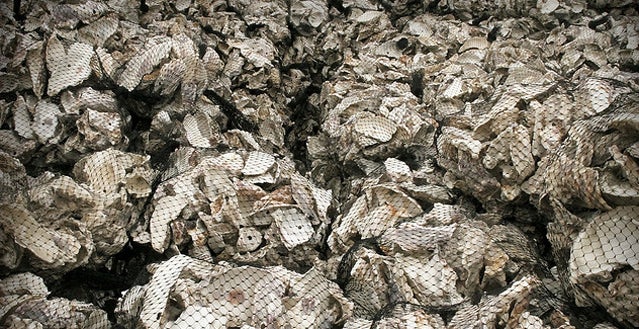
It's been a year of important milestones in Marin County,
California. The Golden Gate National Recreation Area, which includes the Marin
Headlands, turned 40. The Golden Gate Bridge hit 75 years. Further north, the
Point Reyes National Seashore is 50. Now, an oyster farm's lease to operate on
National Park Service land inside the National Seashore has expired. Secretary
of the Interior Ken Salazar rejected pleas to extend and renew the lease, ending a highly charged battle between Drakes Oyster Company,
the National Park Service, and environmental groups.
During the 1960s, both the headlands and the beaches along
the Point Reyes Peninsula were under threat by developers who wanted to build
up and subdivide those landscapes, so locals pushed for protection, fought
hard, and won. It's difficult to imagine what Point Reyes would look like today
if it had been developed and a planned major freeway cut through West
MarineÔÇölet alone a proposed nuclear power plant.
But recently, the Drakes Oyster Company has been at the
center of a storm over the Drakes Estero, a 2,000-acre, ecologically important
estuary in which it operates. In 1962, Point Reyes National Seashore was added
to the National Park System and sections of it were later deemed to become
wilderness areas. In 1972, the National Park Service bought out the Johnson
Oyster Company and granted it a lease to continue operating for 40 years. When
Kevin Lunny purchased the company in 2004, his lawyers told him they could
likely get the lease extended, .
The accusations on both sides have been fierce. In a
polished, ,
Drakes Bay Oyster Company accuses the government of looking for environmental
harm where it does not exist and says the National Park Service has hid
information that would have exonerated the company from claims that its
operations hurt the estero and its federally protected harbor seals. In the
video, Corey Goodman, a neuroscientist and biotech entrepreneur
who Drakes Bay called in to fact-check the Park Service's findings, accuses the
NPS of scientific misconduct.
But the Sierra Club, the , and the Natural Resources Defense Council are among the
groups who applaud Salazar's decision, saying that moving forward with a marine
wilderness designation for the esteroÔÇömaking it the first such area on the
West CoastÔÇöis the right thing to do.
BOATS AND BIVALVES
“The Lunny's have been fabulous with all of the kayak
companies and we never had any disturbances from them,” says Pamalah MacNeily,
co-owner of , which guides sea kayak trips into the estero and surrounding coastal areas,
such as Tomales Bay. She says a claim in the environmental impact report (produced
as part of the lease renewal request) stating that noise from Drakes Oyster
Co.'s motor boats were disruptive to kayakers in the estero is unfounded.
“We never had any disturbances from [the boats], and we're there more than
anybody,” she says.
Coming to the company's defense only invited threats from a
local environmental group. “I've heard people say they will boycott our
business because I was saying that we got along with the Lunny's,” MacNeily
says.
That said, Blue Waters Kayaking has a somewhat symbiotic
relationship with Drakes Bay Oyster Co. MacNeily says many of the hundreds of
clients her company brings into the estero each year “love to go to the
oyster farm after kayaking.” She says they like to know oysters are
locally farmed.
MacNeily also says she's not sure whether the National Park
Service will place any restrictions on her operation once the estero is
converted to a marine wilderness area. Given the many other areas in which she
operates, restrictions wouldn't kill her business, but she'd rather see guided
trips into the estuary than solo boaters. “Drakes is an advanced paddle
and it tends to be windier in the afternoon,” MacNeily says. “If you've gone to the mouth you've
already done four or five miles and you need to go back into a headwind that
can reach 20 or 30 miles an hour. It's safer to have commercial companies.”
MacNeily also feels professional guides are better prepared than
many recreational boaters to avoid scaring the resident harbor seals, one of
the sensitive species in the estero. The has accused Drakes Bay Oyster Co. of operating its motorboats too close to the creatures.
PRECEDENT
While the direct impact of the decision is localizedÔÇöand
felt most by the farm employees and the local seafood industry, as Drakes Bay
Oyster Co. is said to have produced 40 percent of the local oyster marketÔÇöit
does set a precedent that pro-wilderness advocates will likely point to in
future land use debates.
President Obama's nomination of Salazar to lead the
Department of the Interior was met with mixed reactions among
environmentalists. In a December 2008 interview with , Kierán Suckling, executive director of the Center for Biological Diversity, said
“heÔÇÖs got a very mixed record on the environment, at best,”
and pointed to Salazar's weakness on endanger species protection and his
earlier support of Gale Norton for Secretary of Interior, whose term is better
known for corruption than environmental protection.
Under Salazar's watch, the Department of Interior has been
criticized for its handling of the Deepwater Horizon spill, but Salazar has also
rolled back some of the allowances that oil and gas developers enjoyed on
public land during the Bush era. And he approved the highly contentious Cape
Wind energy project.
Salazar's decision over the Drakes Estero lease could end up being
minor compared to the bigger issues he faces over oil and gas exploration,
water use in the increasingly arid West, and wild horse and wolf conservation. But
aquaculture producers and environmental groups will not soon forget it.
ÔÇöMary Catherine O'Connor